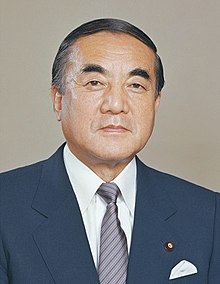
Back Yasuhiro Nakasone Afrikaans ياسوهيرو ناكاسونه Arabic Yasuhiro Nakasone AST Yasuhiro Nakasone Bislama ইয়াসুহিরো নাকাসোনে Bengali/Bangla Yasuhiro Nakasone Catalan Jasuhiro Nakasone Czech Yasuhiro Nakasone Welsh Yasuhiro Nakasone Danish Nakasone Yasuhiro German
Yasuhiro Nakasone | |
|---|---|
中曽根康弘 | |
 Official portrait, 1982 | |
| Prime Minister of Japan | |
| In office 27 November 1982 – 6 November 1987 | |
| Monarch | Shōwa |
| Deputy | Shin Kanemaru |
| Preceded by | Zenkō Suzuki |
| Succeeded by | Noboru Takeshita |
| President of the Liberal Democratic Party | |
| In office 25 November 1982 – 31 October 1987 | |
| Vice President | Susumu Nikaidō |
| Secretary-General | Susumu Nikaidō Rokusuke Tanaka Shin Kanemaru Noboru Takeshita Shintaro Abe |
| Preceded by | Zenkō Suzuki |
| Succeeded by | Noboru Takeshita |
| Member of the House of Representatives | |
| In office 26 April 1947 – 10 October 2004 | |
| Constituency | Gunma 3rd district (1947–1996) Northern Kanto PR (1996–2004) |
| Personal details | |
| Born | 27 May 1918 Takasaki, Gunma, Empire of Japan |
| Died | 29 November 2019 (aged 101) Tokyo, Japan |
| Political party | Liberal Democratic |
| Spouse |
Tsutako Nakasone
(m. 1945; died 2012) |
| Children | Hirofumi Nakasone |
| Alma mater | Tokyo Imperial University |
| Signature |  |
| Military service | |
| Allegiance | Empire of Japan |
| Branch/service | Imperial Japanese Navy |
| Years of service | 1941–1945 |
| Rank | Lieutenant-commander (as Naval Paymaster) |
| Battles/wars | World War II |
Yasuhiro Nakasone (中曽根 康弘, Nakasone Yasuhiro, 27 May 1918 – 29 November 2019) was a Japanese politician who served as prime minister of Japan from 1982 to 1987. His political term was best known for pushing through the privatization of state-owned companies and pursuing a hawkish and pro-U.S. foreign policy.
Born in Gunma Prefecture, Nakasone graduated from Tokyo Imperial University and served in the imperial navy during the Pacific War. After the war, he entered the National Diet in 1947 and rose through the ranks of the Liberal Democratic Party, serving as chief of the Defense Agency from 1970 to 1971 under Eisaku Satō, international trade and industry minister from 1972 to 1974 under Kakuei Tanaka, and administration minister from 1980 to 1982 under Zenkō Suzuki. As prime minister, he passed large defense budgets and controversially visited the Yasukuni Shrine. A conservative contemporary of U.S. president Ronald Reagan, Nakasone privatized Japan's railroad and telephone systems, and favored closer ties with the U.S., once calling Japan "America's unsinkable aircraft carrier". After leaving office in 1987, he was implicated in the Recruit scandal, causing the influence of his LDP faction to wane before he retired from the Diet in 2004.